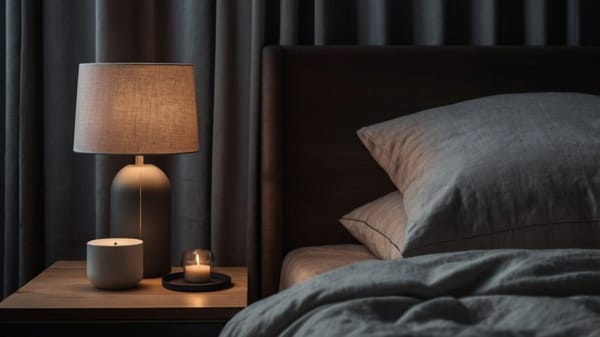Sleepwalking: Why It Happens and How to Manage It
Discover what causes sleepwalking, how to manage it, and the science-backed habits that help you sleep deeper, longer, and more peacefully.

Ever wake up more tired than when you went to bed—and wonder if your body’s been moving while your brain stayed behind? If sleepwalking’s on your radar, you're not alone.
Whether it’s you or someone you care about, it's not just weird midnight behavior—it’s a sign your sleep system is off-track.
This guide breaks down what’s really going on and gives you the tools to restore deep, uninterrupted sleep that leaves you sharp, calm, and fully charged.
What Sleepwalking Actually Is (and Isn’t)
Let’s kill the myths upfront. Sleepwalking isn’t about acting out dreams or buried emotions. It’s not some subconscious escape.
It’s a breakdown in how your brain transitions between sleep stages. Most episodes happen during deep non-REM sleep—specifically, stage 3, which is also called slow-wave sleep.
That’s when your body should be locked down, recovering, and regenerating. But sometimes, your brain misfires.
In sleepwalking, the motor centers of the brain “wake up” just enough to move, while the regions responsible for memory, awareness, and decision-making stay asleep.

That means you might walk, talk, or even open doors, all without conscious awareness. You’re not dreaming—you’re in a sort of neurological limbo where your body’s up and moving but your mind isn’t fully online.
Sleepwalking is more common in children, but plenty of adults deal with it, especially when sleep quality is compromised.
It’s often tied to genetics, but that doesn’t mean you’re stuck with it. Your nightly routines, sleep environment, and overall stress levels play a much bigger role than you might think.
Why Your Brain Sleepwalks: The Real Triggers
Sleepwalking isn’t random. It’s a signal that your brain isn’t transitioning through sleep cycles cleanly. The most common disruptors include:
- Sleep deprivation: When your brain doesn’t get enough deep sleep, it goes into overdrive to make it up. This rebound effect can cause unstable transitions that lead to sleepwalking.
- Stress and anxiety: High cortisol levels mess with your sleep architecture, increasing arousals from deep sleep and making episodes more likely.
- Irregular sleep schedules: Shifting your bedtime or wake-up time confuses your internal clock, making your brain more likely to glitch out during transitions.
- Alcohol or sedatives: These don’t “knock you out”—they fragment your sleep. That’s the perfect storm for sleepwalking.
- Poor sleep hygiene: Too much light at night, screens before bed, an overstimulating bedroom—all of these ramp up brain activity when it should be winding down.
Your goal isn’t to micromanage every detail. It’s to eliminate the chaos that keeps your brain stuck in survival mode at night. That’s when real recovery—and real control—starts to happen.
Reclaiming Sleep: How to Actually Shut Down the Wandering Brain
Here’s where you start gaining ground. You’re not just “trying to sleep better.” You’re giving your brain the signals it needs to power down cleanly, stay asleep, and cycle through each phase of sleep without short-circuiting. Here’s how:
Build a bedtime anchor
You need a set bedtime—and you need to defend it like it matters. Because it does. Sleepwalking thrives when sleep patterns are unstable.
Pick a time that works and stick to it, even on weekends. This trains your circadian rhythm, stabilizing your brain’s sleep transitions.
Train your body to downshift
You can’t go from full throttle to lights out. Sleep is a shutdown sequence, not a switch. Give yourself 30–60 minutes before bed to wind down. Ditch the screens.
Lower the lights. Take a hot shower. Read a book. Keep it boring and repeatable. You're not relaxing for fun—you're conditioning your brain to recognize when it’s time to enter deep sleep.
Clean up the inputs
What you consume late in the day matters. Caffeine lingers in your system for hours. Alcohol fragments your sleep and messes with your REM cycles.
Heavy meals or spicy foods late at night? Another trigger. Create a hard cutoff at least two hours before bed for food and drink. Your gut and brain will both thank you.
Address your stress—on your terms
Sleepwalking often spikes during high-stress periods. You don’t need to meditate for an hour a day. But you do need to downregulate.
Breathwork, light stretching, journaling, or even a tech-free walk can do the trick. The goal is less noise in your nervous system. Less tension = more stable sleep.
Prioritize deep sleep quality
This is the phase where sleepwalking kicks in, so make it solid. Keep your room cool (around 65°F/18°C), dark (blackout curtains or an eye mask), and silent (or use a white noise machine).
The fewer disruptions during deep sleep, the less likely your brain will slip into a partial wake-up.
How to Manage Sleepwalking in the Moment
If you—or someone in your home—does end up sleepwalking, don’t panic. Don’t try to wake them abruptly, either.
That can lead to confusion, disorientation, or even aggressive behavior. Your job is to guide them calmly and safely back to bed. Speak in a soft voice. Gently turn them around. Let their brain settle itself.
You’ll also want to log each episode. When did it happen? What was different that day?
Over time, you’ll start spotting patterns: maybe it happens after late workouts, stressful meetings, or disrupted bedtimes. This is where real improvement comes from—not guessing, but tracking and adapting.
Build a Safe Sleep Space
If sleepwalking’s a regular thing, turn your bedroom into a no-risk zone. You’re not babyproofing—you’re futureproofing. Lock windows and doors.
Add motion sensors or soft alarms if needed. Remove tripping hazards and sharp edges. If stairs are involved, install a safety gate or sleep on a lower level.
And if someone else is the sleepwalker? Let them know what changes you’re making—they’ll thank you in the morning, even if they don’t remember why.
Final Thoughts
Sleepwalking isn’t a mystery—it’s a message. Your brain’s asking for structure, recovery, and consistency. When you give it that, you don’t just stop walking in your sleep.
You sleep deeper. You wake up sharper. Your mood lifts. Your focus locks in. You show up better—everywhere.
Start now. Tonight, pick one habit to lock in: a consistent bedtime, a real wind-down, a screen-free hour. Build the structure. Stick to it. The more predictable your nights become, the more powerful your days will be.
Better sleep starts with smarter habits. And smarter sleep habits start tonight. Ready? Let’s go.




